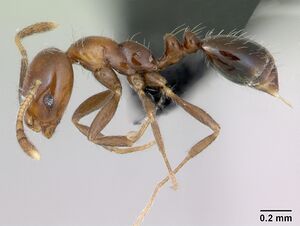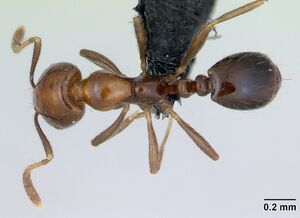Monomorium versicolor
| Monomorium versicolor | |
|---|---|

| |
| Scientific classification | |
| Kingdom: | Animalia |
| Phylum: | Arthropoda |
| Class: | Insecta |
| Order: | Hymenoptera |
| Family: | Formicidae |
| Subfamily: | Myrmicinae |
| Tribe: | Solenopsidini |
| Genus: | Monomorium |
| Species: | M. versicolor |
| Binomial name | |
| Monomorium versicolor Heterick, 2006 | |
Monomorium versicolor prefers a wood substrate for its nests, while individual workers have been collected by such means as beating of low vegetation and sifting of litter. It has been found in a diverse number of vegetation communities including spiny forest, dry tropical forest, montane rainforest and gallery forest. (Heterick 2006)
Identification
Heterick (2006) - A member of the M. flavimembra complex in the M. monomorium species group. This fairly large (worker HML 1.21–1.63 mm), handsome species is readily recognized, principally through its three-toothed mandible and high, vertically attenuate petiolar node. The postpetiole is also high and somewhat compressed, resembling that of Monomorium platynode. The different color pattern and the shape of the clypeus distinguish it from that species. The body color of workers varies from a light brownish-orange with darker gaster to uniform blackish-red, and in many workers the propodeum in dorsal view is distinctly darker than the promesonotum. In lighter colored workers the brown antennal scapes are always slightly to distinctly darker than the head capsule. The anteromedian clypeal margin is broadly depressed, as in other members of the Monomorium flavimembra complex. The queen and male are equally distinctive, with three strong teeth on each mandible. The occipital angles in queens and males are produced to form a small lobe or sharp angle, which is best seen in dorsal view. The wings of reproductives are pale and the veins are weak, becoming obsolete distally
Keys including this Species
Distribution
Latitudinal Distribution Pattern
Latitudinal Range: -18.0264° to -25°.
| North Temperate |
North Subtropical |
Tropical | South Subtropical |
South Temperate |
- Source: AntMaps
Distribution based on Regional Taxon Lists
Malagasy Region: Madagascar (type locality).
Distribution based on AntMaps
Distribution based on AntWeb specimens
Check data from AntWeb
Countries Occupied
| Number of countries occupied by this species based on AntWiki Regional Taxon Lists. In general, fewer countries occupied indicates a narrower range, while more countries indicates a more widespread species. |

|
Estimated Abundance
| Relative abundance based on number of AntMaps records per species (this species within the purple bar). Fewer records (to the left) indicates a less abundant/encountered species while more records (to the right) indicates more abundant/encountered species. |

|
Biology
Castes
Worker
Images from AntWeb
  
| |
| Worker. Specimen code casent0433301. Photographer April Nobile, uploaded by California Academy of Sciences. | Owned by CAS, San Francisco, CA, USA. |
Queen
Images from AntWeb
   
| |
| Queen (alate/dealate). Specimen code casent0026023. Photographer April Nobile, uploaded by California Academy of Sciences. | Owned by CAS, San Francisco, CA, USA. |
Nomenclature
The following information is derived from Barry Bolton's Online Catalogue of the Ants of the World.
- versicolor. Monomorium versicolor Heterick, 2006: 149, figs. 25, 67, 68 (w.q.m.) MADAGASCAR.
- Type-material: holotype worker, 39 paratype workers, 3 paratype queens, 27 paratype males.
- Type-locality: holotype Madagascar: Prov. Toliara, Rés. Berenty, Forêt Malaza, 8.6 km. 314° NW Amboasary, 25°00’S, 46°18’E, 40 m., 6.ii.2002, BLF 5434, ex rotten log, gallery forest (B.L. Fisher, et al.); paratypes with same data.
- Type-depositories: CASC (holotype); ANIC, BMNH, CASC, MCZC (paratypes).
- Distribution: Madagascar.
Unless otherwise noted the text for the remainder of this section is reported from the publication that includes the original description.
Description
Worker
Holotype. HML 1.50 HL 0.58 HW 0.51 CeI 89 SL 0.48 SI 93 PW 0.32.
HML 1.21–1.63 HL 0.49–0.62 HW 0.41–0.55 CeI 82–89 SL 0.38–0.52 SI 85–101 PW 0.25–0.36 (n=20).
HEAD: Head oval; vertex planar or weakly concave; frons shining and smooth except for piliferous pits; pilosity of frons a mixture of well-spaced, distinctly longer erect and semi-erect setae interspersed with shorter decumbent setae or setulae. Eye moderate, eye width 1–1.5× greatest width of antennal scape; (in full-face view) eyes set above midpoint of head capsule to set below midpoint of head capsule; (viewed in profile) eyes set around midline of head capsule; eye elliptical, curvature of inner eye margin may be more pronounced than that of its outer margin. Antennal segments 12; antennal club three-segmented. Clypeal carinae indistinct; anteromedian clypeal margin straight, or, emarginate, clypeal carinae indistinct; paraclypeal setae moderately long and fine, curved; posteromedian clypeal margin extending slightly beyond level of posterior margin of antennal fossae. Anterior tentorial pits situated nearer antennal fossae than mandibular insertions. Frontal lobes sinuate, divergent posteriad. Psammophore absent. Palp formula 2,2. Mandible with three evenly sized teeth; mandibles with sub-parallel inner and outer margins, smooth (except for piliferous pits); masticatory margin of mandibles approximately vertical or weakly oblique; basal tooth approximately same size as t2 (three teeth present).
MESOSOMA: Promesonotum shining and mainly smooth, vestigial striolae, if present, confined to lower anterior mesopleuron; (viewed in profile) promesonotum broadly convex; promesonotal setae greater than twelve; promesonotal setae a mixture of well-spaced, distinctly longer, erect and semi-erect setae which are curved distally and often paired, interspersed with much shorter, incurved, decumbent setae; appressed promesonotal setulae few, mainly on sides of promesonotum. Metanotal groove weakly impressed, with faint costulae or costulae lacking. Propodeum shining and smooth, with a few weak striolae on metapleuron; propodeal dorsum flat throughout most of its length; propodeum smoothly rounded or with indistinct angle; standing propodeal setae consisting of two or more prominent pairs anteriad, often with another pair of prominent setae posteriad, and other smaller setae on/around dorsal and declivitous surfaces of propodeum; appressed propodeal setulae well-spaced and sparse; propodeal spiracle equidistant from metanotal groove and declivitous face of propodeum. Vestibule of propodeal spiracle absent or not visible. Propodeal lobes present as rounded flanges.
PETIOLE AND POSTPETIOLE: Petiolar spiracle lateral and situated within anterior sector of petiolar node; node (viewed in profile) cuneate, vertex rounded; appearance of node shining and smooth throughout; ratio of greatest node breadth (viewed from front) to greatest node width (viewed in profile) about 3:4; anteroventral petiolar process present as a thin flange tapering posteriad, or, absent or vestigial; ventral petiolar lobe present; height ratio of petiole to postpetiole about 4:3; height–length ratio of postpetiole between 3:2 and 4:3; postpetiole shining and smooth; postpetiolar sternite without anterior lip or carina, or this structure vestigial.
GASTER: Pilosity of first gastral tergite consisting of well-spaced, erect and semi-erect setae interspersed with a few appressed setulae.
GENERAL CHARACTERS: Color variable: from concolorous dark reddish-brown to orange-and-brown, or orange, gaster chocolate, antenna always darker than head in lighter-colored specimens. Worker caste monomorphic.
Queen
HML 1.81–1.94 HL 0.58–0.64 HW 0.49–0.53 CeI 80–84 SL 0.45–0.54 SI 90–102 PW 0.37–0.38 (n=5).
HEAD: Head rectangular; vertex weakly concave or planar; frons shining and smooth except for piliferous pits; (viewed dorsally), occipital angles of head capsule conspicuous, lobate; pilosity of frons a mixture of well-spaced, distinctly longer erect and semi-erect setae interspersed with shorter setae or setulae, which are decumbent or appressed, longer setae thickest on vertex. Eye elliptical, curvature of inner eye margin may be more pronounced than that of its outer margin; (in full-face view) eyes set below midpoint of head capsule; (viewed in profile) eyes set posteriad of midline of head capsule.
MESOSOMA: Anterior mesoscutum smoothly rounded, thereafter more-or-less flattened; pronotum, mesoscutum and mesopleuron shining and mainly smooth, vestigial striolae, if present, confined to anterior katepisternum; length–width ratio of mesoscutum and scutellum combined between 2:1 and 3:2; axillae narrowly separated (i.e., less than width of one axilla); standing pronotal/mesoscutal setae a mixture of well-spaced, distinctly longer, erect and semi-erect setae which are curved distally, interspersed with much shorter, incurved, decumbent setae; appressed pronotal, mescoscutal and mesopleural setulae few, mainly on sides of pronotum and mesopleuron. Propodeum shining and smooth, with a few weak striolae on metapleuron. Propodeum oblique, more-or-less straight; propodeal dorsum flat throughout most of its length; standing propodeal setae consisting of up to a dozen or more longer erect and shorter sub-erect setae; appressed propodeal setulae well-spaced and sparse; propodeal spiracle equidistant from metanotal groove and declivitous face of propodeum. Propodeal lobes present as well-developed, rounded flanges.
WING: Wing not seen (queens dealated).
PETIOLE AND POSTPETIOLE: Petiolar spiracle lateral and situated within anterior sector of petiolar node; node (viewed in profile) cuneate, vertex tapered. Appearance of node shining and smooth; ratio of greatest node breadth (viewed from front) to greatest node width (viewed in profile) between 2:1 and 3:2; anteroventral petiolar process present as a thin flange tapering posteriad; height ratio of petiole to postpetiole between 4:3 and 1:1; height–length ratio of postpetiole between 7:3 and 2:1; postpetiole shining and smooth; postpetiolar sternite without anterior lip or carina, or this structure vestigial.
GASTER: Pilosity of first gastral tergite consisting of a mixture of incurved, erect and semi-erect setae and slightly shorter decumbent setae.
GENERAL CHARACTERS: Color dark chocolate, mandibles orange. Brachypterous alates not seen. Ergatoid or worker-female intercastes not seen.
Male
HML 1.63–1.86 HL 0.49–0.54 HW 0.47–0.53 CeI 94–102 SL 0.15–0.18 SI 31–35 PW 0.45–0.65 (n=10).
HEAD: (In full-face view) head width–mesosoma width ratio between 4:3 and 1:1; frons finely micropunctate. Compound eyes protuberant and elliptical; margin of compound eye clearly separated from posterior margin of clypeus. Ocelli not turreted. Ratio of length of first funicular segment of antenna to second funicular segment between 2:3 and 1:2. Maximum number of mandibular teeth and denticles three.
MESOSOMA: Mesoscutum broadly convex; pronotum and mesoscutum shining and mainly smooth, vestigial striolae, if present, confined to lower anterior mesopleuron; parapsidal furrows distinct; notauli absent; axillae separated by width of at least one axilla.
WING: Wing veins predominantly depigmented, with distal segments reduced to vestigial lines; vein m–cu absent; vein cu–a absent.
PETIOLE AND POSTPETIOLE: Petiolar spiracle lateral and situated within anterior sector of petiolar node; node (viewed in profile) conical, vertex rounded; appearance of node shining and smooth; ratio of greatest node breadth (viewed from front) to greatest node width (viewed in profile) about 1:1; anteroventral petiolar process absent or vestigial; height ratio of petiole to postpetiole between 4:3 and 1:1; height–length ratio of postpetiole between 2:1 and 3:2; postpetiole shining, with vestigial sculpture.
GASTER: Pilosity of first gastral tergite consisting of a mixture of incurved, semi-erect setae and slightly shorter decumbent setae.
GENERAL CHARACTERS: Color chocolate.
Type Material
Holotype: worker, Prov. Toliara, Rés. Berenty, Forêt Malaza, 8.6 km 314 NW Amboasary 25º00’S, 46º18’E 40m, 6.ii.2002 Fisher et al BLF #/ex rotten log, gallery forest/CASENT 0042524 5434 (California Academy of Sciences). Paratypes: Prov. Toliara (all specimens with same collection data as holotype): 2 workers, 1 male (Australian National Insect Collection)); 12 workers + 2 queens + 12 males (The Natural History Museum); 3 worker, 1 male (CAS); 22 workers + 1 queen + 13 worker (Museum of Comparative Zoology).
Etymology
Latin ‘of various colors’.
References
References based on Global Ant Biodiversity Informatics
- Heterick B. 2006. A Revision of the Malagasy Ants Belonging to Genus Monomorium Mayr, 1855 (Hymenoptera: Formicidae). Proceeding of the California Academy of Sciences (PCAS) 57: 69-202
- Ravelomanana A., and B. L. Fisher. 2013. Diversity of ants in burned and unburned grassland , and dry deciduous forest in the Beanka Reserve, Melaky Region, western Madagascar. Malagasy Nature 7: 171-183.

